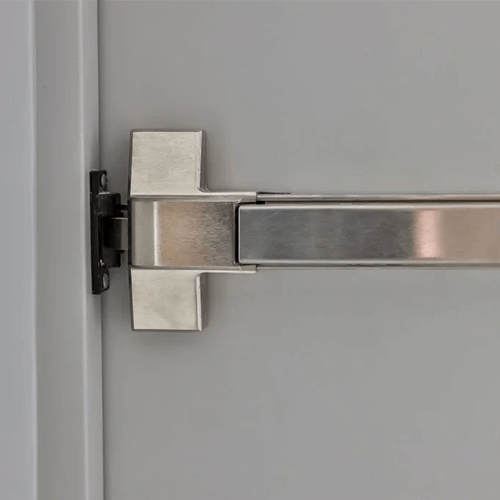
We’ll go ahead and answer the headline question right upfront: it depends on a lot of variables. These include what kind of commercial building is in question, what the permitted occupancy load is, and what particulars govern the building code through the local permitting and inspection authority.
In case you didn’t know, crash bars are those horizontal bars about midway up on the average commercial door that allow you easy egress from a commercial building. They allow you to open the door by pushing with your hands, your hip, or that heavy box you’re carrying.
The idea here is that not a lot of force is required to release the latch that holds the door shut, and crucially, there is also no need for twisting or grasping.
According to the National Fire Prevention Association and the International Building Code, which is itself developed by the International Code Council, there are a few instances in which buildings are required to have crash bars:
You can usually find the permitted occupancy load of a given building displayed in a prominent place where people tend to gather.
The permit placement intends to keep people informed for their general safety. Crash bars are part of a standardization system that aims to enhance safety by normalizing and standardizing egress systems. And they work.
The idea in the design of crash bars is that when people are panicking and trying to get out of the building, they shouldn’t need to think about how to operate the latch system on the door. Because these systems require releasing under only 15 pounds of force, the latch should release if anyone or anything forces against the door.
There are other organizations that regulate how crash bars work. The Builders Hardware Manufacturers Association (BHMA) grades the quality of these devices for durability, among other things.
Any product that is certified as BHMA Grade 1 has been tested to withstand 500,000 cycles without failure. If you think that’s a high standard, think again: it’s not uncommon for high-traffic commercial doors to perform a million cycles in a year (with just two cycles per minute, on average).
That’s why it’s important to regularly inspect your door hardware for faults and replace it if it’s beginning to cause problems.
A commercial building’s crash bars absolutely need to be Americans with Disabilities Act (ADA) compliant. Remember how egress latch devices must not require grasping or twisting? That’s because of ADA compliance. This stuff matters for occupant safety.
Another organization influencing the standardization of door hardware is the Underwriter’s Laboratory (UL). This operation independently evaluates manufacturers’ claims through testing and random spot checks on their production lines. When a product is UL listed, you can be confident that it has undergone rigorous testing.
Some commercial egress points feature a delayed release mechanism. You may have seen retail facilities with emergency exits that display information like this. Authorities typically impose restrictions on delayed egress crash bar systems and often mandate interconnection with a sprinkler system to comply with regulations.
One of the intentions behind the delayed release system is to allow retail personnel to apprehend thieves. Perpetrators cannot simply trigger the emergency exit, gain access to the building’s exterior, and flee.
These systems usually include a 15-second delay, but they disable this delay during a fire due to their typical interconnection with a fire suppression system.
Delayed egress systems also keep hospitals and other institutions more secure. An unattended, easily manipulated emergency exit poses a major security risk to large buildings with vulnerable occupants.
If you do, CDF Distributors is the provider to call first. We have many styles of crash bars in a range of finishes to coordinate with any decor. Contact us today and put our online Pro Builder tool to work for you. Choose your product, get an instant quote, and have it shipped to you in as little as three days. It’s that easy.